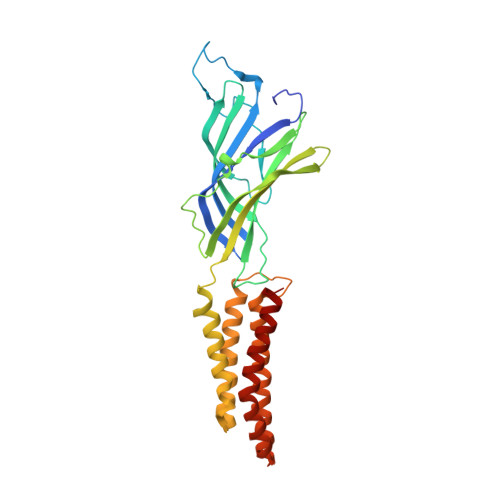Signal Transduction at the Domain Interface of Prokaryotic Pentameric Ligand-Gated Ion Channels.
Bertozzi, C., Zimmermann, I., Engeler, S., Hilf, R.J., Dutzler, R.(2016) PLoS Biol 14: e1002393-e1002393
- PubMed: 26943937
- DOI: https://doi.org/10.1371/journal.pbio.1002393
- Primary Citation of Related Structures:
5HEG, 5HEH, 5HEJ, 5HEO, 5HEU, 5HEW - PubMed Abstract:
Pentameric ligand-gated ion channels are activated by the binding of agonists to a site distant from the ion conduction path. These membrane proteins consist of distinct ligand-binding and pore domains that interact via an extended interface. Here, we have investigated the role of residues at this interface for channel activation to define critical interactions that couple conformational changes between the two structural units. By characterizing point mutants of the prokaryotic channels ELIC and GLIC by electrophysiology, X-ray crystallography and isothermal titration calorimetry, we have identified conserved residues that, upon mutation, apparently prevent activation but not ligand binding. The positions of nonactivating mutants cluster at a loop within the extracellular domain connecting β-strands 6 and 7 and at a loop joining the pore-forming helix M2 with M3 where they contribute to a densely packed core of the protein. An ionic interaction in the extracellular domain between the turn connecting β-strands 1 and 2 and a residue at the end of β-strand 10 stabilizes a state of the receptor with high affinity for agonists, whereas contacts of this turn to a conserved proline residue in the M2-M3 loop appear to be less important than previously anticipated. When mapping residues with strong functional phenotype on different channel structures, mutual distances are closer in conducting than in nonconducting conformations, consistent with a potential role of contacts in the stabilization of the open state. Our study has revealed a pattern of interactions that are crucial for the relay of conformational changes from the extracellular domain to the pore region of prokaryotic pentameric ligand-gated ion channels. Due to the strong conservation of the interface, these results are relevant for the entire family.
Organizational Affiliation:
Department of Biochemistry, University of Zürich, Zürich, Switzerland.














